Climate Change Strategy and Management
As the world’s leading provider of industrial computers and business networking technologies and services, Advantech understands its responsibility to the global environment policy statement on climate change is consistent with the goal of Paris Agreement to limit the global temperature rise below 1.5° C. After passing the sciencebased target (SBT) in 2021 and committing to the SBT, we further joined the RE100 initiative in 2023 and committed to achieving the goal by 2040, considering renewable energy as an important strategy for moving towards net zero, and setting the goal of achieving net zero by 2050. Starting from 2025, to further accelerate our carbon reduction plans, we will adopt the 1.5° C SBT as our carbon reduction goal for the next decade and continue to promote global initiatives such as RE100 across all RBUs.
Advantech has included climate change as one of the material risk projects of corporate sustainable management, and has managed it according to the two standpoints of "mitigation" and "adaptation." Meanwhile, we are also actively identifying risks, building adaptation capabilities, further researching and analyzing opportunities for climate change, and accumulating and deepening R&D momentum. We continue to invest in eco energy and in energy-saving products and solutions, and we are integrating them with the core business of energy management to promote energy saving and sustainability.
Advantech's Net Zero Vision
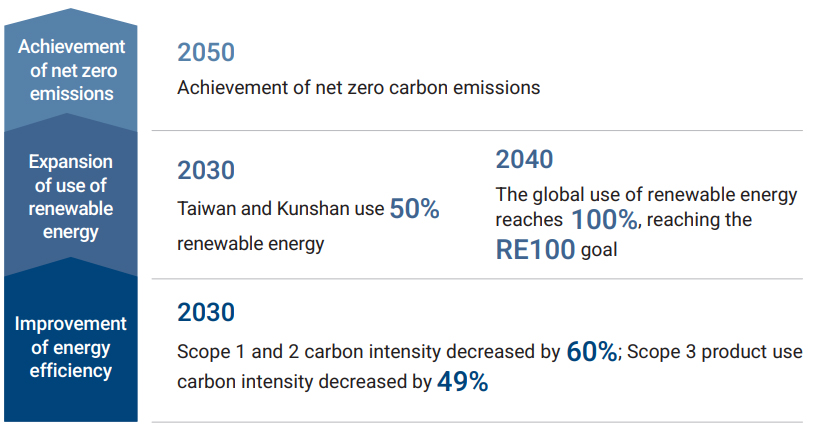
Advantech's Climate Change Development History
2019
- Launch of ISO 14064 Greenhouse Gas Inventory and Verification Program in Taiwan and Kunshan
- Base year for Advantech's ScienceBased Target (SBT)
- CDP Climate Change Ranking Receives 'B’
2020
- Establishment of ESG Corporate Sustainability Committee and ESG Office
- Introduction of green product plan to produce low-carbon products
- CDP Climate Change Ranking Receives 'B’
2021
- The Science-Based Target (SBT) adopted to comply with the international below 2°C
- Commitment and support for Task Force on Climate-Related Financial Disclosures (TCFD)
- 10 MW of low-carbon investment solar power plants to supply Taiwan factory
- CDP Climate Change Ranking Receives 'B’
2022
- Establishment of the Sustainability Development Committee (SDC) at the board level
- Completion of Task Force on Climate-Related Financial Disclosures (TCFD) risks and opportunities assessment
- Initiation of the inventory and verification plan for all categories of ISO 14064 Greenhouse Gas Scope 3 (Scope 3)
- Obtained green factory certification of Kunshan factory
- CDP Climate Change Ranking Receives 'B’
2023
- Commitment to climate change strategy and net-zero vision
- Commitment to join RE100 targets and process active low-carbon investment
- Link between the ESG KPI and the performance also approved by the Board
- Initiation of the subsidiary's greenhouse gas inventory and verification plan
- Initiation of the electricity consumption of the main business bases collected by iEMS in Taiwan and Kunshan
- Obtained green factory certification of Taiwan factory
- Obtained ISO 50001 certification of Taiwan and Kunshan operating bases
- Obtained the first product carbon footprint ISO 14067 certification
- CDP climate change rating of “B”
2024
- The linkage of senior managements compensation to ESG and climate change issues and achievements
- Implement the internal carbon pricing (ICP) program and define carbon pricing
- Promote the GHG inventory and verification program of subsidiaries in Asia
- Completed the global iEMS to monitor and analyze the electricity consumption of main operating locations around the world
- Increase the use of renewable energy across global RBU locations
- Calculate the representative product’s carbon footprint of each business group and complete the application of Advantech's methodology
- Develop green packaging materials, green materials and energy-saving design products by incorporating LCA assessments
- CDP climate change rating of “B”
2025
- Increase the coverage of the GHG inventory and verification at major overseas operational sites.
- Apply the latest IPCC assessment report to recalibrate climate scenarios and incorporate new assessments of nature-related risks and opportunities, resulting in the publication of Advantech’s 2024 Climate- and Nature-related Financial Disclosures (TC(+N)FD) Report.
- Update SBT to align with the 1.5°C pathway and achieve net zero carbon emission.
- Continue to increase renewable energy usage across global RBUs to reach 20%.
- Implement a pilot Internal Carbon Pricing (ICP) program to strengthen carbon reduction efforts and achieve carbon reduction goals.
- Develop and launch the Product Carbon Footprint Calculation System 1.0 using AI technology, supporting the promotion of green products.
- Launch a supply chain carbon management capacity building program to empower key suppliers.
2026
- Completion of the global ISO 14064 greenhouse gas inventory and verification plan
2030
- Achieved Scope 1 and 2 carbon intensity decreased by 60%; Scope 3 product use carbon intensity decreased by 49% of SBT target
- Taiwan and Kunshan use 50% of renewable energy
2040
- The global use of renewable energy reaches 100%, reaching the RE100 goal
2050
- Achievement of net zero carbon emissions
Advantech’s SBT Targets
Advantech actively aligns with international initiatives and announced the SBT commitment in 2021, aiming to take concrete actions to reduce carbon emissions through scientifically grounded reduction goals. We plan to update our SBT to align with the 1.5° C pathway by 2025.

TCFD Climate Governance and Management Strategy
Extreme weather events caused by climate change, the growing pressure for low-carbon transitions due to aggressive national carbon reduction goals, and carbon reduction demands from upstream and downstream value chain partners have already begun to pose potential operational challenges for enterprises. In response to the growing global emphasis on linking identified climate risks with financial impacts, Advantech has adopted the TCFD framework. We promote climate change management and disclosure based on the four core elements recommended by the TCFD: governance, strategy, risk management, and metrics and targets. This systematic approach allows Advantech to assess the climate risks and opportunities we face. We conduct in-depth evaluations of climate-related risks identified through our existing risk management processes and map them across our Pan-Operational Risk Map to ensure comprehensive coverage of our overall operational risk landscape. The assessment results and response plan has also been reported to the Senior management of the SDC for confirmation, and the SDC will report the progress of climate management to the Board of Directors on a regular basis to enhance the Company's resilience in responding to climate risks. For more details on our climate risk and opportunity disclosures and management actions, please refer to the “2024 Advantech Task Force on Climateand Nature-related Financial Disclosures.“
Climate Change Risk and Opportunities

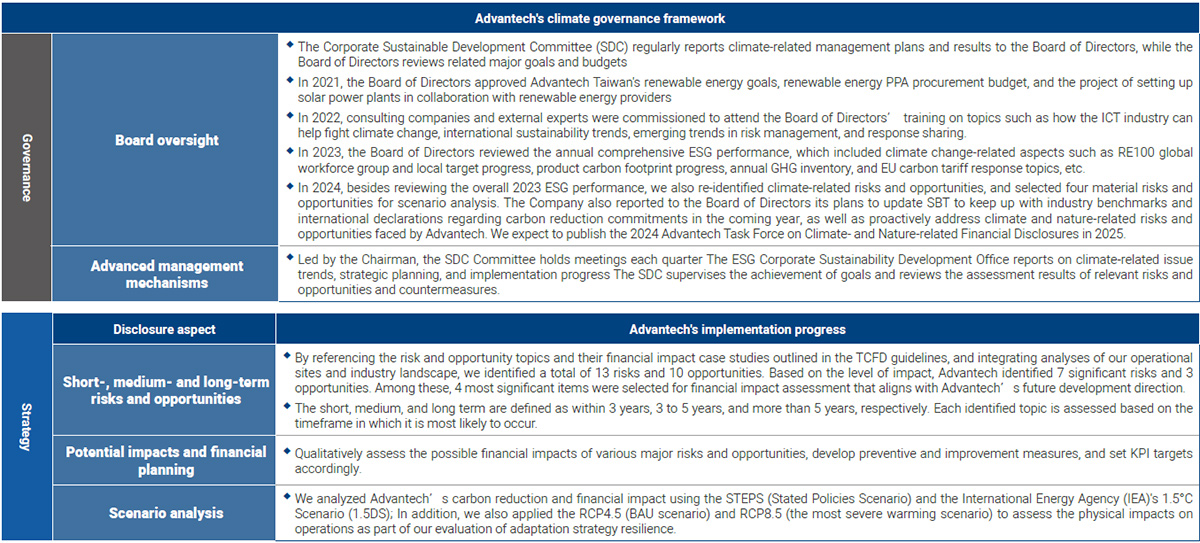
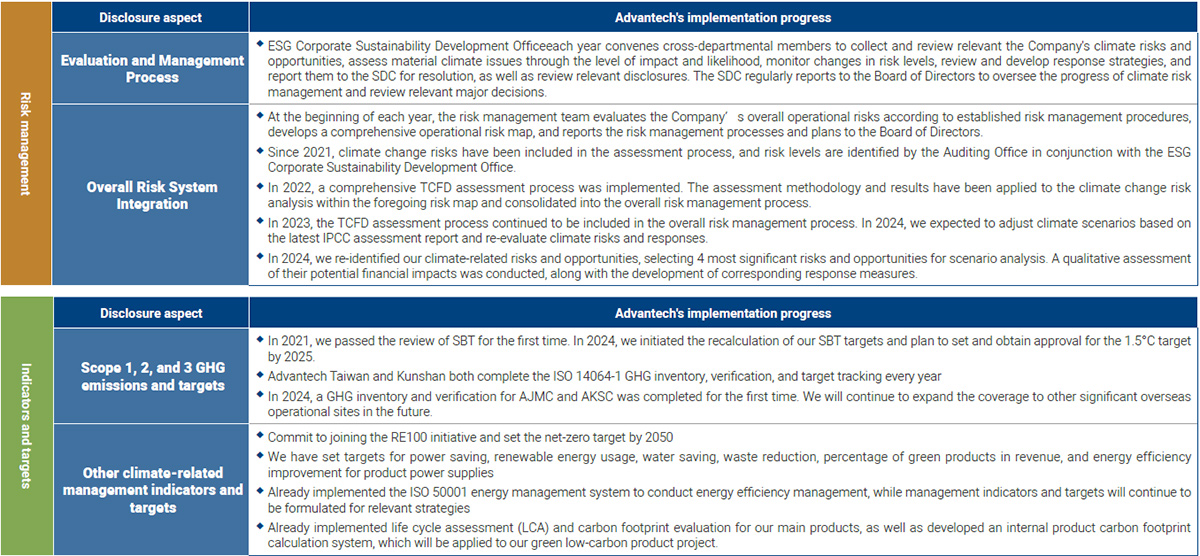
Identification of Climate-Related Risks and Opportunities, and Financial Implications
Advantech identifies significant climate-related risks and opportunities by referencing the risk and opportunity definitions outlined in the TCFD framework, combined with multidimensional issue collection, cross-departmental discussions, and external consultations Through this process, we concretely identify significant risks and opportunities relevant to Advantech, their potential occurrence scenarios and impact levels, and analyze their possible financial implications. We focus on operational aspects (reduction, natural disasters), product aspects (including the supply chain), and market aspects based on industry characteristics and international developments. This enables us to comprehensively inventory climate risks and opportunities at the organizational level and develop precise response strategies. Consequently, Advantech's climate risk management covers the entire value chain, including upstream, downstream, and our own operations. Advantech's climate-related risks and opportunities, financial impact evaluation process, items, and materiality assessment results are shown in Figure.
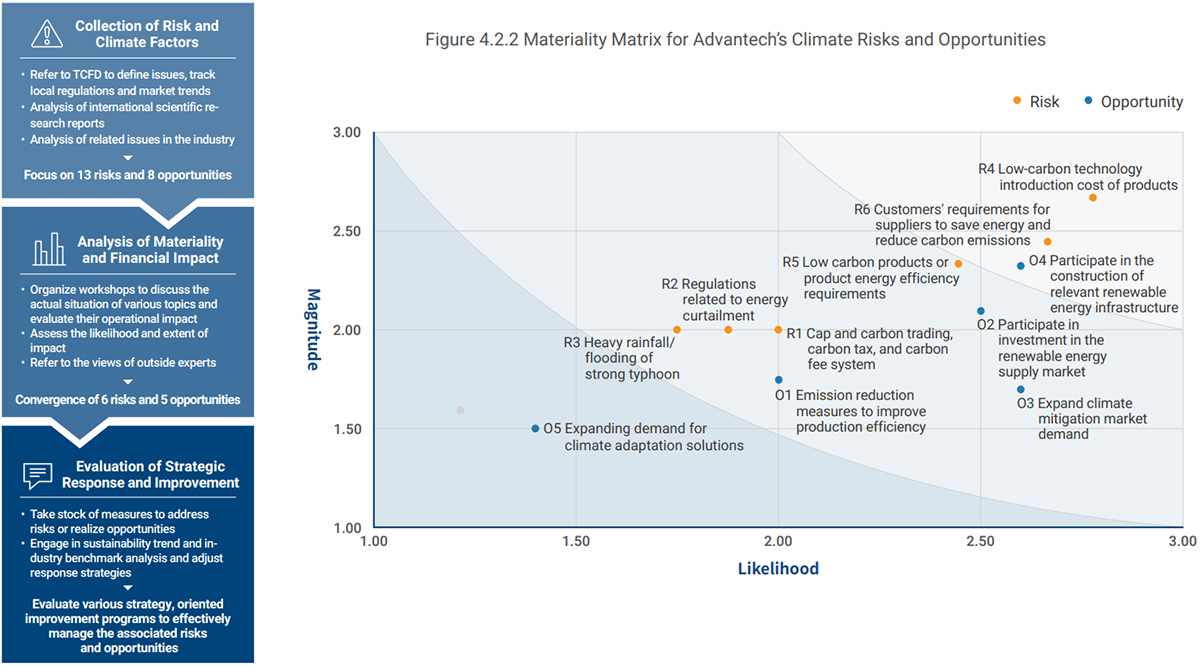
Results of a scenario analysis of Climate Change risks
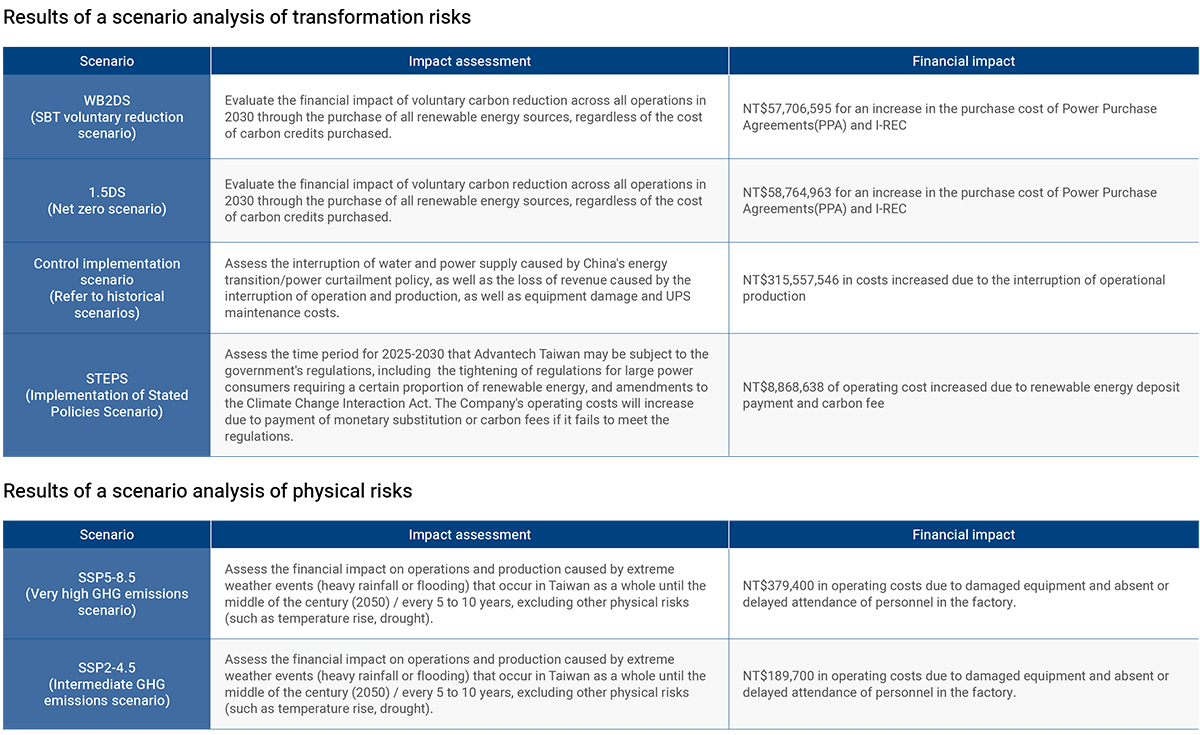
Climate-related risk and opportunity assessment results and response strategies
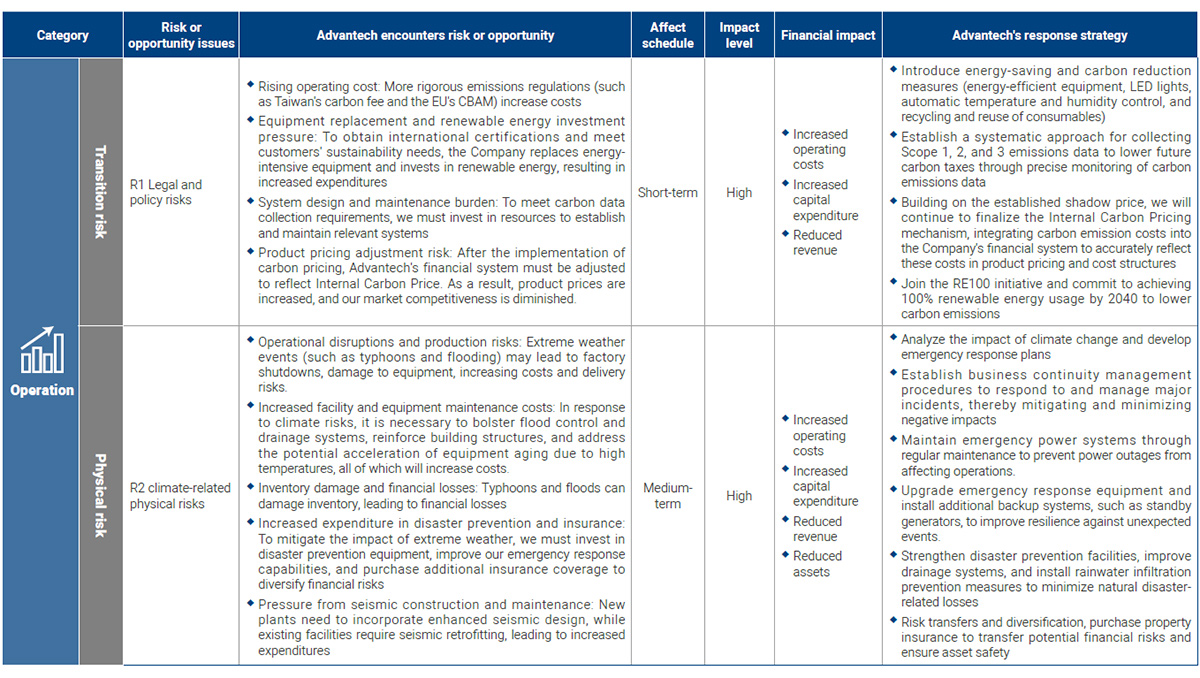
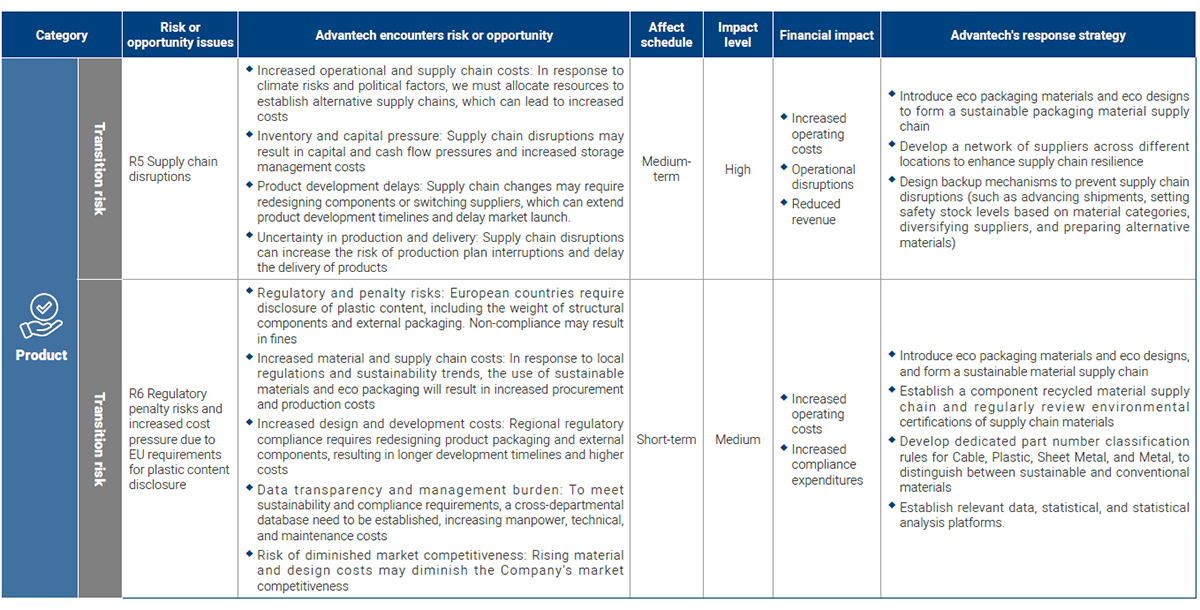
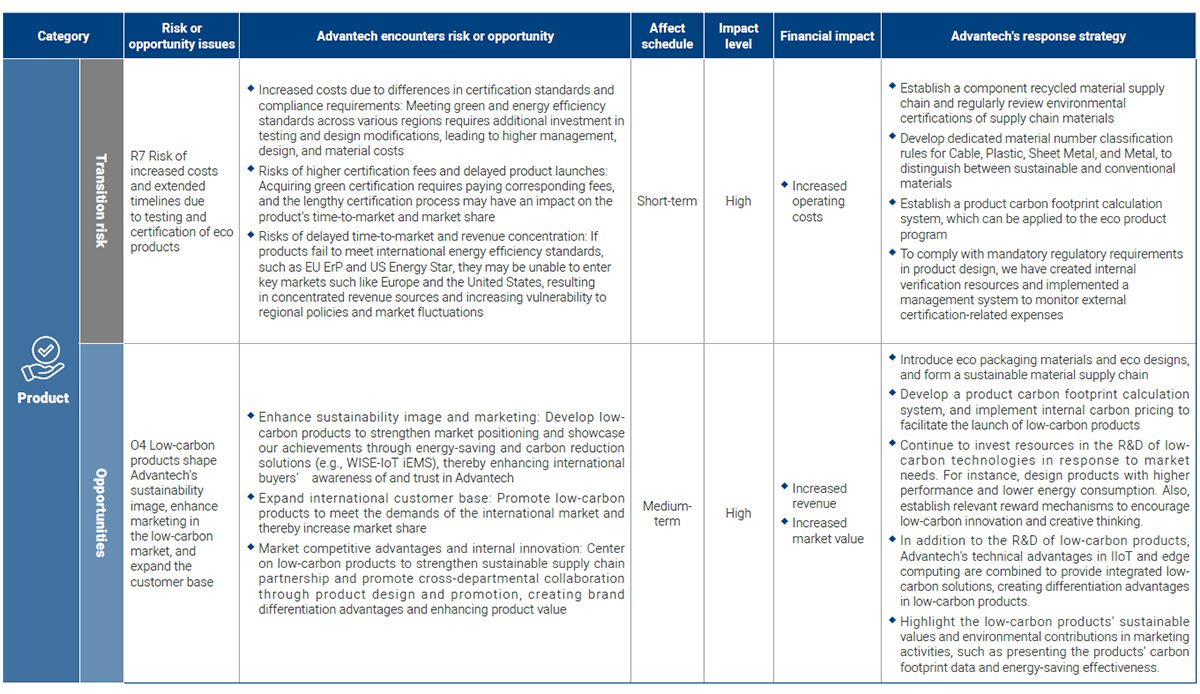


1. Impact level: conduct internal assessments based on the likelihood of occurrence and the degree of impact, dividing them into “High,” “Medium,” and “Low."
2. Impact period: considering when occurrence might happen, divided into "short term (< 3 years) ,” “medium-term (3-5 years),” and “long-term (>5 years).”
